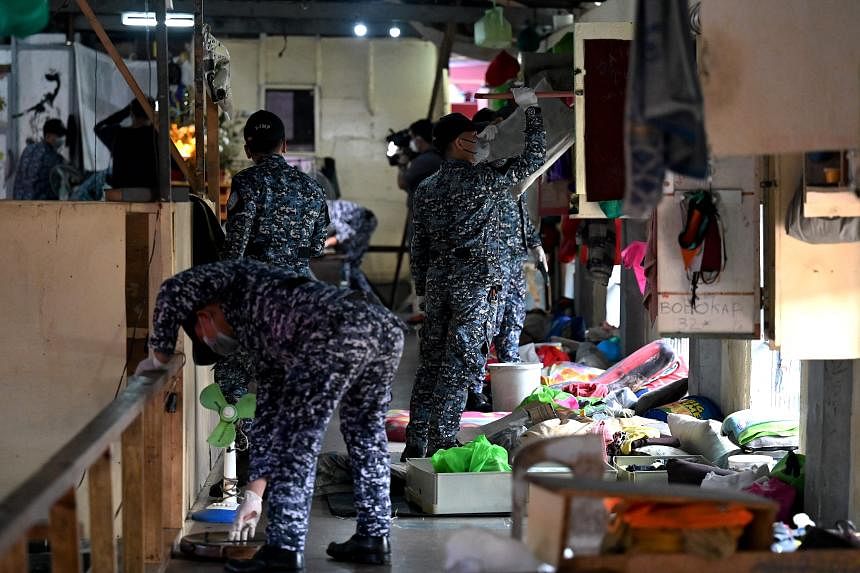8 hangars in area of 15 hectares work 24/7 since 2019 with 55,000 computers to make Bitcoin
4/01/2023 Wednesday
AA

Kazakhstan stands among the world’s leading countries in Bitcoin production although there has been tax rises and limitation to the access of electricity toward cryptocurrency producers over the past year.
According to the latest report published by Cambridge University experts in January 2022, Kazakhstan, which ranks third after the US and China with a share of 13.22% in cryptocurrency mining, has about 300 crypto mines.
Anadolu Agency has displayed the data center of Enegix company, which has been operating in the country since 2019 and is among the largest crypto mines across the world.
To get to the huge facility near the city of Ekibastuz in the country’s northern region, it is necessary to travel about 300 kilometers (over 186.4 miles) from the capital Astana.
It is no coincidence that the facility is located in Ekibastuz as the cold climate of this place in winter and the mild climate in summer allow crypto computers that work continuously day and night to work regularly without heating up.
Built on a total area of 15 hectares in the middle of a wide steppe and where strict security measures are taken, there are eight large hangars where computers designed for cryptocurrency mining are placed.
As many as 55,000 computers are working there non-stop to earn Bitcoin, the most expensive cryptocurrency in the world, for its owners.
However, those who enter these hangars for the first time are greeted by a noise they are not used to. This buzz coming out of the machines is called by crypto miners the “sound of digital money.”
Yersayin Nurtoleuov, the director of the Hosting Department of Enegix Company, told Anadolu Agency that as a company, they hold a 1.3% share of global Bitcoin.
He said the facility has the power to provide customers with 180 megawatts of electricity per hour, saying: "We call our customers who have placed their device (computer) in our data center investors.”
“They only bring their devices here. We take care of the subsequent processes such as switching on the devices, connecting them to the internet, and providing access to the global crypto network power.
“In other words, our company hosts crypto mining devices in general and provides the basic infrastructure for their operation,” he stressed.
Noting that they have all kinds of opportunities at the facility for Bitcoin mining, the director mentioned that the most important of them is the uninterrupted provision of electricity and 24/7 supervision of devices.
He emphasized that they employ more than 100 people so that not a single computer is disabled.
"Usually young Information Technologies specialists work,” he said, adding that they train these employees themselves.
“Due to the fact that they work with a 15-day shift method, there is a dormitory and a dining hall within the boundaries of our facility,” he also said.
- Consuming 3.5 kilowatts of electricity per hour
The data centers of the facility, monitored by over 150 cameras, are also constantly monitored by system operators such as Ilya Fomin.
Fomin explained that his main task is to do his best to ensure that the Bitcoin devices in the data center are operational 24/7, saying: "If these devices work, the Bitcoin network also works and crypto production is carried out."
Expressing that the most important raw material for the operation of the Bitcoin devices is electricity, Fomin noted: "A Bitcoin device located in the data center in this hangar consumes 3.5 kilowatts of electricity per hour.
“So if there is no electricity, it means that there is no crypto money either,” he underlined.
He said the essence of Bitcoin mining consists of the direct transmission of transactions without any intermediaries.
"These devices with chips reveal a string of letters and numbers that are too long to be broken to create the necessary cache for Bitcoin or other cryptocurrencies.
“After all this, the data transaction is considered to have been successfully transferred, and the owner of the device receives a profit in the form of Bitcoin or other cryptocurrencies,” he underscored.
The authority of the facility, which was the world's second-largest crypto mine last year, stressed that they are working with imported electricity because of the crisis in Kazakhstan and the world, adding that they have limited their activities as Bitcoin has lost some of its value in the world.
Meanwhile, Nurtoleuov said that as a company, they see these as temporary problems and said: "If we look at the Bitcoin graph, we see that it is always fluctuating.”
“We are experiencing the 'crypto winter' this year,” he said, expressing that they expect a significant rise this year to “about $100,000.”
- Digital mining ‘licensed activity'
Sergey Putra, a member of the Kazakhstan Blockchain and Data Center Industry Association, pointed out that some of the disputes between the government and the industry are due to the lack of legal order.
Putra underlined that the main problem is crypto mines operating unregistered, saying: "A large number of crypto devices have been smuggled into the country by illegal means.”
“Now those who have obtained these devices are mining crypto money by hiding in places such as car washes, pizzerias.”
Criticizing that they are against it, he noted: “We support crypto mines that we call 'white miners' who pay taxes and have data centers.”
The draft law "On Digital Assets" that will legalize cryptocurrency mining is being discussed in the Kazakh parliament, Putra stressed, saying he also took part in the preparation of the draft law as an expert.
Putra explained that the process was difficult because a draft law had not been developed in such a sector in the country before, emphasizing: "With this draft law, digital mining will now be a licensed activity.”
“These licenses will be issued in two categories. The first category will cover the owners of data centers where mining equipment is placed, and the second will cover only the individual entrepreneur who has a mining computer,” he mentioned.
According to another article in the draft law, all mining devices to be brought to the country from now on will be marked and registered in a single system, Putra said, stressing that this is important for the transparency of the sector.
He also said electricity consumption below 1 megawatt will be prohibited in crypto mining, adding: "This is the lowest ceiling we have set to prevent those who mine unregistered cryptocurrency in a 1-megawatt home environment, garage, or other places."



















